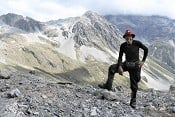In reply to Luca Karjalainen:
Rutschblock - the "table" (with a big caveat!) I was taught (full size, ski-length rutschblock, not the smaller compression tests with shovel) was something like this:
1) collapse when digging or cutting or skier getting on the block or just bouncing on the block - DANGER, do not enter at all
2) collapse during shock weighting by the skier (first jump) - VERY POSSIBLE DANGER, avalanches quite possible even by single skier, make precautions in planning and keep distances
3) collapse after multiple shock weighting by the skier - the same, slightly less but nearly the same!
4) collapse after shock weighting (jumping) without skis in boots, etc. - possible but rarer avalanche even by single skier
5) no collapse - "almost" impossible avalanche
The big caveat I mentioned is that obviously you make a rutschblock in a safe location (unless you are crazy), which might be quite different from the tour conditions (even if you do it on the same aspect).
And since many compression tests are not gonna tell you much unless you are a professional and full rutschblocks are bloody time expensive, you should still definitely do them if in doubt, but rely more on prevention and safe planning (former weather, aspects, avalanche forecasts if available, avoiding terrain traps and avoiding heuristic traps - human factor)...
All in all, the rutschblock and other methods are just a tool for when in doubt, safe tour planning (or cancelling) should still come first.
EDIT: Very nicely summarised by AdrianC's reply below mine Esp. the large set of information needed to estimate risk. It's just one of the tools to estimate it, and should not come above the others.
Post edited at 19:20









